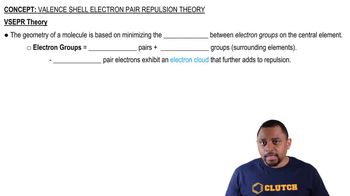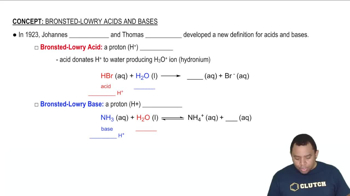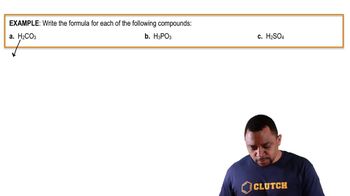Ch.22 - Chemistry of the Nonmetals
Chapter 22, Problem 59
Complete the exercises below. Account for the following observations: a. Phosphorus forms a pentachloride, but nitrogen does not. b. H₃PO₂ is a monoprotic acid. c. Phosphonium salts, such as PH₄Cl, can be formed under anhydrous conditions, but they cannot be made in aqueous solution. d. White phosphorus is more reactive than red phosphorus.
 Verified step by step guidance
Verified step by step guidance1
Step 1: Consider the electronic configurations of phosphorus and nitrogen. Phosphorus has the electronic configuration [Ne] 3s² 3p³, allowing it to expand its octet and form five bonds, such as in PCl₅. Nitrogen, with the configuration [He] 2s² 2p³, lacks available d orbitals and cannot expand its octet, limiting it to a maximum of three bonds.
Step 2: Analyze the structure of H₃PO₂. This compound is known as hypophosphorous acid. It has one hydrogen atom bonded to oxygen (which can be ionized) and two hydrogen atoms bonded directly to phosphorus, making it a monoprotic acid as only one hydrogen is ionizable.
Step 3: Examine the formation of phosphonium salts like PH₄Cl. In anhydrous conditions, PH₃ can react with HCl to form PH₄Cl. In aqueous solutions, PH₃ is a weak base and does not readily form PH₄⁺ ions due to the presence of water, which can hydrolyze the salt.
Step 4: Compare the structures of white and red phosphorus. White phosphorus consists of P₄ tetrahedra, which are highly strained and reactive. Red phosphorus has a polymeric structure, making it more stable and less reactive than white phosphorus.
Step 5: Summarize the key differences in reactivity and bonding capabilities between phosphorus and nitrogen, and between different allotropes of phosphorus, to account for the observations.
Key Concepts
Here are the essential concepts you must grasp in order to answer the question correctly.
Valence Shell Electron Pair Repulsion (VSEPR) Theory
VSEPR theory explains the geometry of molecular structures based on the repulsion between electron pairs in the valence shell of atoms. This theory helps to understand why phosphorus can form a pentachloride (PCl₅) due to its ability to expand its octet, while nitrogen, with its smaller size and higher electronegativity, cannot accommodate more than four bonds.
Recommended video:
Guided course

Valence Shell Electron Pair Repulsion Theory
Acid-Base Theory
Acid-base theory, particularly the Brønsted-Lowry definition, categorizes acids as proton donors and bases as proton acceptors. H₃PO₂ being a monoprotic acid indicates it can donate only one proton (H⁺) in solution, which is crucial for understanding its behavior in chemical reactions and its classification among acids.
Recommended video:
Guided course

Bronsted-Lowry Acid-Base Theory
Allotropes of Phosphorus
Phosphorus exists in several allotropes, including white and red phosphorus, which exhibit different reactivities due to their structural differences. White phosphorus is more reactive because it has a tetrahedral structure that is strained, making it more prone to react with other substances, while red phosphorus has a more stable polymeric structure.
Recommended video:
Guided course

Naming Oxyacid Example
Related Practice
